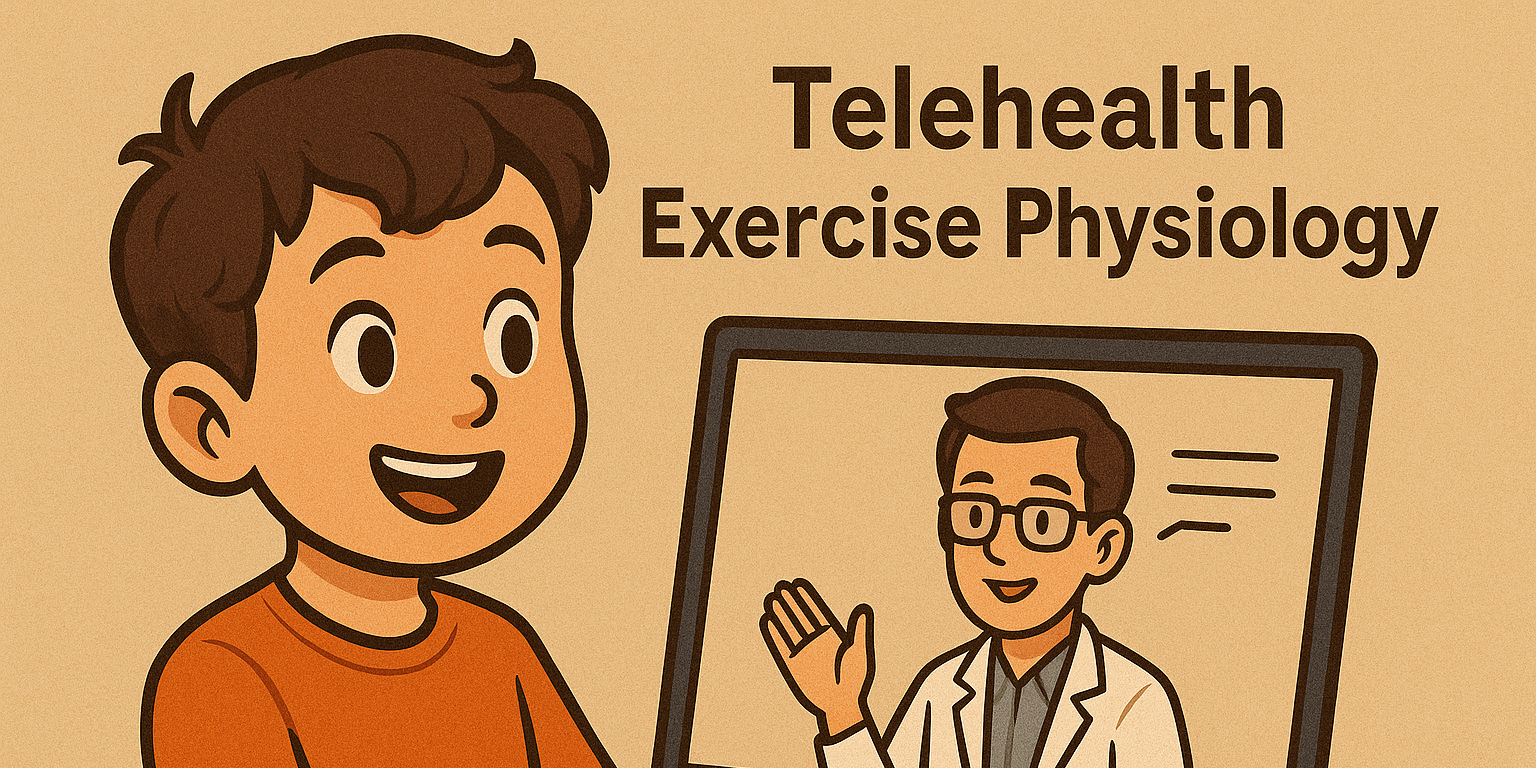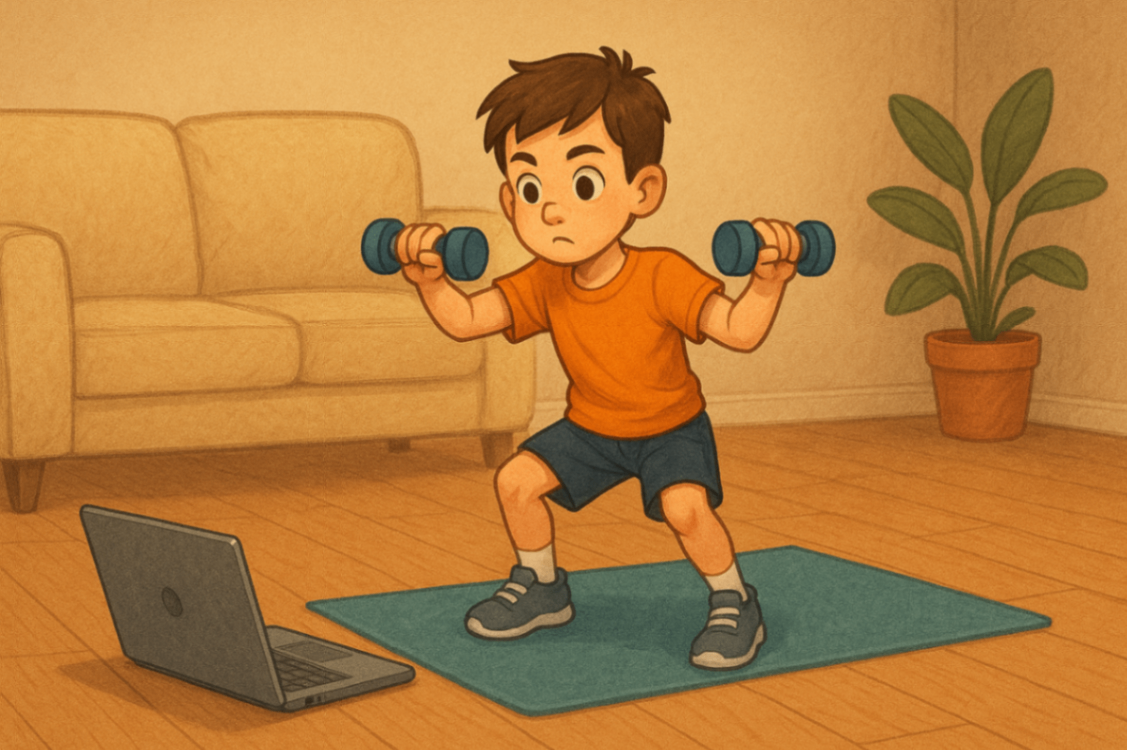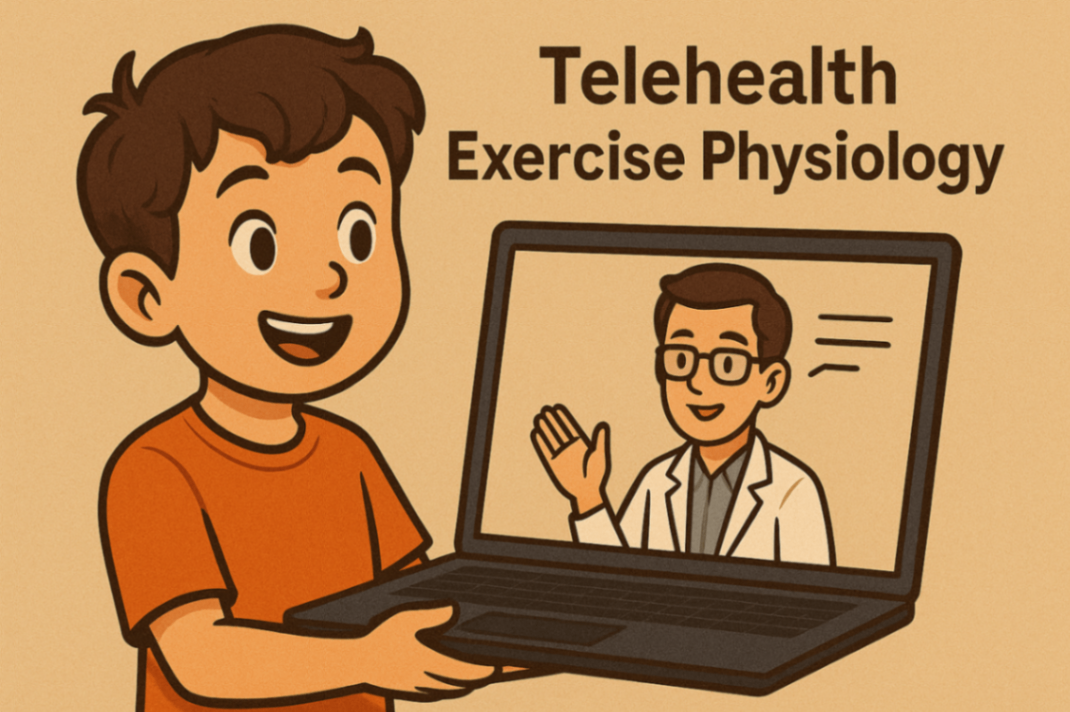
telehealth exercise physiology: what you need to know
23 July, 2025

Key Highlights
-
Investigate how telehealth exercise physiology Liverpool services have revolutionised healthcare with tailored programs from afar.
-
Learn how exercise physiology for kids via telehealth keeps little ones active, boosts mobility and builds lifelong healthy habits.
-
Understand how NDIS exercise physiology telehealth sessions make specialist support accessible under your NDIS plan.
-
Understand the role of exercise physiologists in delivering personalised physical activity programs to improve quality of life.
-
Learn about prominent digital platforms, consultation procedures, and the technology enabling these services.
-
Explore conditions such as chronic diseases, musculoskeletal disorders, and neurological impairments treated via telehealth.
-
Discover how accessible these services are for remote areas, rural communities, and your first-interaction expectations.
Introduction
Telehealth exercise physiology is changing the way we look at healthcare. It uses technology to let people work with professional exercise physiologists from their own homes. In these online meetings, patients get custom plans that focus on things like better mobility, more strength, and sticking to exercise routines. This helps people stay active and improve their health and vitality.
You can use telehealth if you are dealing with long-term health issues, healing after surgery, or just want to get better at fitness. With telehealth, you get the care you need, when you need it. This makes healthcare easy to reach and keeps people on track with their exercise. It is a good step forward, bringing help to rural communities and the general population, too.
For advice on what to ask practitioners about experience, NDIS-awareness and outcome tracking, read How to Find an Exercise Physiologist — Near Me, Today.
What is telehealth exercise physiology and how does it work?
 Telehealth exercise physiology combines remote healthcare with physical training, allowing individuals to receive personalised exercise plans and guidance via digital platforms. Utilising video calls, fitness apps, and monitoring devices, professionals assess clients' needs and progress, ensuring effective support while promoting health and wellness from the comfort of their homes.
Telehealth exercise physiology combines remote healthcare with physical training, allowing individuals to receive personalised exercise plans and guidance via digital platforms. Utilising video calls, fitness apps, and monitoring devices, professionals assess clients' needs and progress, ensuring effective support while promoting health and wellness from the comfort of their homes.
Structured programs in exercise physiology help you work on your functional capacity. These programs are great for people who live in remote areas or where there is less access to healthcare. This can suit you if you are getting better from muscle or joint surgery or if you deal with chronic conditions. Telehealth helps keep your care steady, and you can use it at times that work for you. The next part looks at the tools and online platforms, including resources from Scand J Med Sci Sports, you use with this type of telehealth care.
For a deeper understanding of how movement science supports better health outcomes, visit our guide on Understanding Exercise Physiology: Goals and Practices.
Technology and Platforms Used
Telehealth exercise physiology uses new tools and online platforms to help keep patients involved. Common services like Zoom or Microsoft Teams let people and physiologists take part in live exercise sessions. The physiologist can see how you move and give you personal tips. These platforms offer good audio and video, making it easier to guide you through things like posture, stretches, or other parts of exercise work.
|
Platform Name |
Functionality in Telehealth Services |
|---|---|
|
Zoom/Teams |
High-resolution video calls for visual assessment |
|
Wearables |
Track physical activity—steps, heart rate, mobility |
|
Exercise Portals |
Provide video libraries of exercises and rehab tutorials |
But it's not all about the software. Telehealth also brings in wearables that track physical activity, step count, heart rate, mobility, and how people stick to their exercise plans. These devices check your physical performance and keep up with other baseline health signs. Secure portals hold your progress logs. This helps keep you on track and makes it easier to plan for the future.
When you add in health education, these tools and platforms make telehealth services simple, fast, and useful. This way, you get care in a format that really works for you—even from far away. Once you start a virtual consultation, you will find out how your personal exercise session starts.
The Virtual Consultation Process
Your telehealth consultation is simple but covers all that you need. It starts with your first check-up. When you talk with your exercise physiologist, they will look at your physical activity level. They will also ask about any worries you have and talk to you about your health care goals for recovery. Before your meeting, you fill out forms. This helps the health care workers understand if you have any injuries, long-term illnesses, or other issues.
After this, a plan that fits you is made. These plans can use different things, like stretches, cardio, or ways to get stronger. These each help improve your physical activity and health. The session will also look at how you sit or stand and will talk about your functional capacity. The health care worker will check on you again later. These follow-ups help you stick to your plan and reach your goals. If you are getting better after surgery or you have a neurological condition, telehealth lets health care teams watch and tweak your plan. This makes sure it works for you in the best way.
Benefits of Telehealth Exercise Physiology
 Telehealth exercise physiology can help you see big changes in your quality of life and the way you move every day. These programs are made just for you. They fit your routine, so the chances of keeping up with them are better. When you do sessions from home, it removes many trouble spots. This is very good for people in rural places or for those who have a hard time getting around.
Telehealth exercise physiology can help you see big changes in your quality of life and the way you move every day. These programs are made just for you. They fit your routine, so the chances of keeping up with them are better. When you do sessions from home, it removes many trouble spots. This is very good for people in rural places or for those who have a hard time getting around.
You can use telehealth to get stronger after surgery or handle long-term health problems. It lets you make small changes and keep a steady plan that fits your days. The focus is not just on exercises, but also on how you live your life, which can give you better health. These healthcare services give more people help. It sets a bar for care in places far from hospitals—as you will see ahead.
To see how these principles apply to younger clients, explore our blog on Children’s Exercise Physiology in Liverpool, where we dive into how physical activity supports healthy development from an early age.
Improving Access for Rural and Remote Communities
Rural communities often deal with big problems when they need specialist care. They may not be able to travel or find the expert help they need. Telehealth makes it easier to get care, bringing exercise physiologists into homes. People just need smart devices and internet to join exercise sessions. These sessions help with chronic pain, mobility problems, or recovery.
Clinics that use telehealth often change exercise sessions to match local ways of life. This helps improve physical activity and matches routines with the place people live in. Telehealth is good for those who live in remote areas. Studies also say it works for many health issues, like neurological problems or obesity. This new way to give healthcare helps to fix unfairness for rural people. It lets them stay active most of the time, without a lot of changes to their day.
Convenience and Flexibility for Patients
Telehealth exercise physiology gives people a high level of flexibility. It fits well into the lives of the general population. You can book a session on your work break or in the evening. This freedom makes it easier to fit into busy schedules and helps to take away stress.
-
Location-Neutral Interventions: Exercise sessions happen online and match what patients need.
-
Reduced Transportation Effort: You do not have to travel for online sessions.
-
Comprehensive support tools: Devices like wearable monitors give clear feedback.
This is great for busy professionals. People who have limited mobility also get help, as they can do rehab at home. Telehealth makes it simple to keep your routines steady. It helps people stick to their plan, which leads to better results. Now, let’s look at what health conditions telehealth can help manage.
Conditions Commonly Managed via Telehealth Exercise Physiology
 Telehealth services help people with many health problems. It can help with chronic diseases, nerve issues, and movement problems. Exercise plans help people take care of diabetes, get better after heart problems, and recover from cancer.
Telehealth services help people with many health problems. It can help with chronic diseases, nerve issues, and movement problems. Exercise plans help people take care of diabetes, get better after heart problems, and recover from cancer.
There are also mobility routines made to help with stiff joints or joint injury after surgery. This way, telehealth can be changed for each person, no matter how bad the problem is. It allows you or people you know to keep track of progress and helps with rehab. Telehealth is flexible, giving real support for anyone who wants modern healthcare and better mobility. Let’s start by looking at how telehealth helps with long-term diseases.
Chronic Disease Management (e.g., Diabetes, Cardiac Rehab)
Managing long-term health problems like diabetes and heart disease can really get better with telehealth exercise physiology. With online consultations, exercise physiologists make personal plans to help people be more active. These plans match a person’s own health needs and can make their quality of life better. Regular exercise sessions are set up just for you, which helps people follow their rehab much more. This is important for care that needs to go on all the time, like heart rehab. Doing regular exercise is good for keeping up your strength and can improve the way you feel and live. This is especially helpful for older adults who live in remote areas where the healthcare you get is not always easy to reach. Telehealth makes it easier for these people to get help from exercise physiologists, stick to their plans, and boost their physical activity to support their health and functional capacity.
Musculoskeletal and Post-Surgical Rehabilitation
Rehabilitation for musculoskeletal and post-surgical problems has improved a lot with new telehealth services. Exercise physiologists help people during exercise sessions, which the people can do at home. These sessions can be made to fit each person and focus on making physical performance and functional capacity better. Using telehealth this way helps more people stick with their exercise routine. This help is important for those living in remote areas. By doing physical activity often, people can take charge of their own rehabilitation. They get better at moving, which leads to a higher quality of life over time. Regular exercise and support from telehealth can make sure recovery and mobility stay on track.
What to Expect During Your First Telehealth Session

During your first telehealth meeting, a health professional will talk with you about your current physical activity and check your mobility and how well you move. At this time, you will also go over your health history and any long-term conditions you have. This is important so you can get advice that fits you and helps you with your exercise training.
After the assessment, an exercise physiologist will work with you to make goals that you can reach. They will focus on what you need so you can stay motivated and stick to your new plan. You can expect that your exercise program will be made just for you, taking into account your health and daily life. This way, you can improve your quality of life, stay healthy, and add more physical activity to your routine. Telehealth brings a new and better way to get the care you need.
IIf you’re considering both in-person and virtual options, check out our post on what to expect at your first exercise physiology appointment in Liverpool. It outlines how assessments and goal-setting work during clinic-based sessions.
Initial Assessment and Goal Setting
Building a good base at the start is key in telehealth exercise physiology. Health professionals take time to look at a person’s physical performance, how well they can move, and their health history. This helps exercise physiologists to adjust the plan for each person’s needs. Setting goals is very important too. When you set clear and doable targets, it helps people stick with their exercise sessions and makes life better. With this personal touch, people can keep up their energy and have a better chance at getting better or managing a long-term illness.
Personalised Exercise Programming
A tailored exercise plan can help improve the quality of life, especially for those who manage health conditions that last a long time. Exercise physiologists work with each person to make a plan that fits their needs. They take into account your baseline physical performance, your health background, and your goals. This kind of plan looks at the type of exercise you do, how much physical activity you need, and what you can handle. By making a plan just for you, health professionals help people stay with the program, move better, and get the most out of their effort. If you live in a remote area or you cannot get to in-person visits, telehealth services can help. With telehealth, you can talk to health professionals and keep working toward your goals, no matter where you are. This is a good way for people to stay on track and improve their health even when going out is not easy.
How to Access Telehealth Exercise Physiology Services?
To use telehealth exercise physiology services, you’ll need to book an appointment through a trusted provider’s website or app. Make sure you have a stable internet connection and access to a device like a computer, tablet, or smartphone with a camera. This setup will help you participate fully in your sessions and get the most out of your plan.
At daar, booking is quick and easy. Our team of accredited exercise physiologists is ready to support you with personalised telehealth programs—whether you're managing a health condition, building strength, or simply trying to stay active from home.
Book your telehealth session now.
Why Choose daar for Your Telehealth Exercise Physiology
Choosing daar for telehealth exercise physiology means you are putting your health first. You get help from experienced exercise physiologists who are there to support you. They work to help you reach the goals you have set, whether you want better mobility or need help managing long-term health problems. You get care that is made just for you.
Telehealth services from daar give you more options. It is easier for people in remote areas or those who have problems with mobility to get exercise programs that fit their needs. You can work with Daar to keep up with your plan and stay active.
With a focus on making sure you stick to your exercise routines, daar uses telehealth to help you see real changes in your physical performance. You can raise your quality of life with regular and effective physical activity, no matter where you live or what challenges you face.
Conclusion
In the changing world of healthcare, telehealth exercise physiology gives people a new way to get help and improve their quality of life. This lets health professionals and exercise physiologists connect with people who live in remote areas. It makes it easier for them to stick to regular exercise and do physical activity that fits their own needs. With these virtual sessions, patients get the support to boost their physical performance no matter what their baseline mobility or health is. Using this new method is good for helping with ongoing health problems and also gives the general population more ways to find vitality and feel better.
Frequently Asked Questions
Can telehealth exercise physiology replace in-person appointments?
Telehealth exercise physiology can be a good way to add to your in-person visits, but it might not take the place of every appointment. This is true when you need hands-on checks or if your case is more complex. At the same time, these online sessions offer more flexibility and are easy to use. They are a great option if you want support and help while you work on your rehab.
What equipment do I need for telehealth sessions?
For telehealth sessions, you need to have a good internet connection to access the world of telehealth. You will also need a computer or tablet with a camera and a microphone. If your practitioner says you need something like resistance bands or weights for physical activity, make sure you have those, too. Check that your space is right for moving around and doing the exercises.
Is exercise physiology via telehealth effective?
Exercise physiology using telehealth has been shown to work well for a lot of patients. It lets people have programs that fit their needs and gives them steady help, which is very good for chronic disease and rehabilitation. Studies show people get better physical health and feel happy with the care. Because of this, it is a good choice for remote care.
Are telehealth exercise physiology services covered by Medicare or private health funds?
Telehealth exercise physiology services can sometimes be paid for by Medicare and some private health funds as part of the national disability insurance scheme. This can depend on what your own health policy says. It is a good idea to talk to your provider first to know if you have cover for this. Ask them about the rules, who can get it, and if you need a referral from a healthcare professional.
How do I choose a qualified telehealth exercise physiologist?
To pick a good telehealth exercise physiologist, you should check their credentials. Make sure they have experience with your condition. See if they know how to use telehealth tools well. Look for positive reviews from other people or testimonials. It is also good if they give care that is right for your goals and health needs.
.svg)












